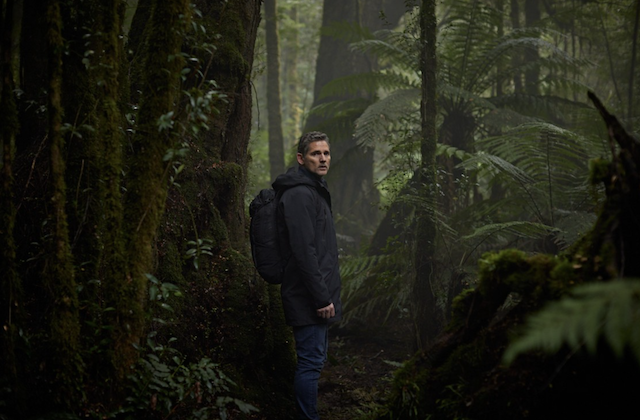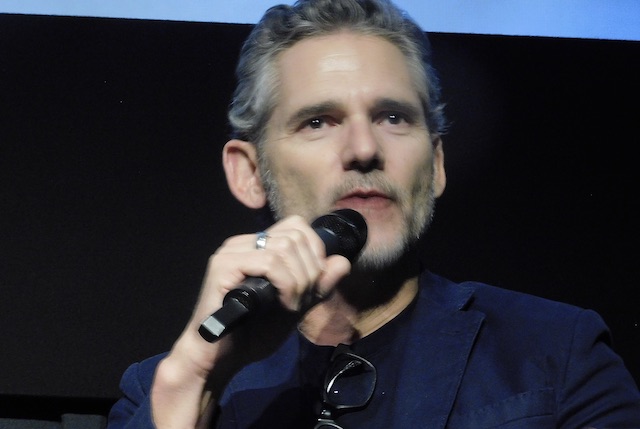
©Courtesy of IFC Films
Force of Nature: The Dry 2 : Five women head out on a remote hiking retreat but only four return, each telling a different story. Detective Aaron Falk (Eric Bana) must find out what really happened before time runs out.
Director : Robert Connolly
Producer : Andrew Myer, Robert Patterson, Joel Pearlman, Ricci Swart
Screenwriter : Robert Connolly
Distributor : IFC Films
Production Co : Made Up Stories
Rating : R (Language)
Genre : Crime, Drama, Mystery & Thriller
Original Language : English
Release Date : (Theaters)May 10, 2024, Limited
Runtime : 1h 53m

Q & A With Director Robert Connolly, Actors Eric Bana, and Deborra-Lee Furness
Q :How do The Dry and Force of Nature: The Dry 2 fit into one another?
Robert Connolly: It was important for us that they could be like standalone films that you could watch, no matter the order in which you see them. We had a double bill play in LA a couple of nights ago and they played Force of Nature first, The Dry second, so you can watch The Dry like a prequel. It was important to us that they could exist in their own right but that they also would offer both some connections. The Dry is also driven by the landscape: this second one is set in a Subtropical rainforest in Australia, while the first one was set in a very drought-stricken farmland area.
Q : Did you approach the two movies differently or in the same way?
Eric Bana : I love that they were inverted in Los Angeles, in the way that in ”The Dry” we start off with Aaron in his personal time going to a friend’s funeral, visiting a country town that he is loathed to return, even if we don’t know why he’s so badly received when he’s there. In The Dry things slowly reveal themselves and he slowly ends up in an investigation.
Whereas in ”Force of Nature : Dry 2,” it’s professional Aaron right from the get-go, he’s investigating in his police role, teamed with Carmen, played by Jacqueline McKenzie. In this movie too the layers are slowly, slowly peeled back and we get the more personal reveal as time goes on. The flashbacks reveal a lot, in this case, Robert had to calibrate how much you give away in the present and how much we are relying on these flashbacks.
Q : Jill Bailey is a new character in the world of “The Dry.” How did you end up in the film?
Deborra-Lee Furness : Rob and Eric are longtime friends and collaborators. I’m an old longtime friend of both of these gentlemen. As they said these two films stand alone. You could see this not having seen The Dry. I came to this because I was asked to join the cast by Robert and Eric, and I was attracted by the strongly female-driven cast and obviously given a chance to work with both of them.
Q : Is it true you made some contributions to the script and the character of Jill?
Deborra-Lee Furness : I can’t help myself. She is the wife of a company’s CEO but it’s also her family’s company, so it’s a complicated situation. When you create a character as an actor you want to make it your own, so I wanted to feel I needed to fight for Jill, to make sure that she had something to say, that she was a fully formed beautiful character with an arc and something to contribute. I was in New York and Rob was in Australia, for over five weeks we’d Zoom on a Saturday night in New York, and Sunday morning in Australia, and we just created together Jill.
We kept her interesting and alive and made her very three-dimensional. She has strength and she has vulnerability, I wanted to make her very believable because she’s put in a very vulnerable position, she’s out of her comfort zone but in survival mode. I loved as an actor that all the masks we use when for example we go to a dinner party, when you’re put out there and you’ve got no food and you haven’t slept and you don’t know how you’re gonna get out of there, these masks come off and you get to see the people behind. I find that fascinating and a challenge as an actor.
Robert Connolly : One of the things Deb was amazing about when we were working on the script together was making sure that every decision that the women made was a real and smart decision. They might make the wrong decision, whether you go down to the river or you go back up the track, but every debate that they’re having is real and reasoned if you’re in that situation. It was definitely something we discussed a lot. The title Force of Nature is about a group of women in lots of ways.
©Courtesy of IFC Films
Q : The whole movie was shot in a National Park, near Victoria. Can you talk about working in the forest?
Robert Connolly : I actually grew up in the Blue Mountains, which is two hours west of Sydney, until I was about 16 and moved to Melbourne. We shot in the Dandenong Ranges National Park, two or three hours out of Melbourne. I love taking audiences into locations, cinema does it really well. The first time I came to New York when I was a teenager, it felt so familiar to me from the movies I’d seen.
I think cinema has a real power to do that, so that’s what I wanted to do. That involves going for authenticity, in order to do that we needed to take the actors into these very remote, tough, difficult places. I’ve been working in the film industry for 30 years and this has been the toughest film I’ve worked on. It was winter, it was cold, and these were leech-infested valleys. The locations had never really been filmed before because they were inaccessible.
Deborra-Lee Furness : I do know about the leeches. They were our friends. Rob got the most. They didn’t like me. Every day was rough and we were climbing mountains, you know, we’re high here up to the top of the mountain. We got to see extraordinary landscapes, which a lot of people wouldn’t see because you wouldn’t get that far into the forest. The landscape is another character in the film that we had to contend with, but as you can see, it’s beautiful. You feel it. It’s exciting. it’s not like being in a studio.
Eric Bana : The waterfall was freezing, let’s be honest, but it was an amazing opportunity. As Rob mentioned we presented a compelling case to the National Park so we could get into these places not the way you normally film. Productions have a large footprint and lots of vehicles and trailers and stuff. I thought: “Well, if I don’t ask for a trailer, none of the cast can ask for a trailer.
Then we can go anywhere”. That was part of our tactics. It was just really special. We’re so excited we can show people from around the world a part of Australia that you may not immediately be associated with this Country. That landscape has really dense forest, it was kind of dangerous and exciting. The head of our safety in the first production meeting sat down and said: “With regards to safety, there’s not much I can do for you out there so just look out for each other”. Everyone realized he wasn’t joking.
Q : Other than Eric and Deborra, Force of Nature: The Dry 2 has a remarkable cast…
Robert Connolly : Absolutely. Anna Torv and Robin McLevy are a credible duo, getting the dynamic of their relationship, which is so critical to the final scene when everything happens. Robin had done a series in the US, Hell on Wheels. Anna worked in Fringe, Minhunters, and The Last of Us. They both did an incredible job. We also had new and emerging talent: Lucy Ansell and Sisi Stringer play Bree and Beth, two sisters who are just dynamite. As a director, you feel this real energy and the promise of these careers ahead. I must say the five together were stunning, I was delighted because there were many days when I would call action and I had no idea what was going to happen. Surely something exciting.
Q : How important was it to be able to rehearse for a few weeks before starting shooting?
Deborra-Lee Furness : We were blessed to have two weeks beforehand to sit around the table, to get to know each other, and to play around and feel our characters. found those two weeks very interesting because all of us are very different women in life. And all our characters are also very different. There were so many levels of challenges to play with.

©Courtesy of IFC Films
Q : Mixing three different timelines adds depth to the story: how did you work at the editing?
Robert Connolly : It was a very long edit, it really came together in maybe the fifth or sixth cut during the edit. It took a while. I endorse the idea that a film is written three times: on the page, during the shooting, and in the edit. We really had to play with the structure quite a lot. The guiding principle was that they were moving between times. It needed to be psychologically motivated by Aaron’s memories or his discoveries, it was it was probably the biggest challenge.
I worked with Maria Papoutsis and Alexander de Franceschi, who edited the Australian film Lion, which was a big success here in the US. I introduced into this movie the story of the young Arron, with his mother going missing, which was not in the book written by Gina Harper. It was only a few references to some photos. We thought that photos wouldn’t really carry the emotional weight that a narrative would, where you actually have glimpses of the past. It’s such a fine line for a filmmaker, trying to work out if something like this is a puzzle that an audience can enjoy or if it’s just confusing. You walk this balance the whole time when you’re editing.
Q : Why did you end up directing the second unit in this movie?
Eric Bana : One of the biggest things that we were fighting against was just light. Shooting in the middle of winter meant the days were really short. So there were just a few shots here and there that we couldn’t afford to put in another day, so It was just helping to get some shots down that Rob just wouldn’t have physically been able to get. It was fun. Like a creative dynamic, we’ve been working together for years. I find my acting so good when I’m directing myself…
If you like the article, share your thoughts below!
Check out more of Adriano’s articles.
Here’s the trailer of the film.

